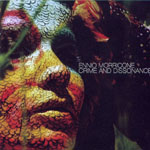|
|
 |
Dusted Reviews
Artist: Ennio Morricone Album: Crime and Dissonance Label: Ipecac Review date: Aug. 29, 2005 |

|
|
|
 |
Despite having composed over 500 movie soundtracks in the past 40 years, Ennio Morricone is really only known for his works in one genre: the spaghetti western. Most of the compilations of his music to date have focuses almost exclusively on this mid-’60s output. And even then, it is the soundtrack to The Good, the Bad, and the Ugly that most quickly rolls off the tongue when you mention Morricone. While his spaghetti western soundtracks are truly revolutionary in their combination of rock, Americana, and contemporary classical/avant-garde techniques (see here for a slightly more thorough rant), they in reality only represent the smallest fraction of what Morricone is about as a composer. He is much more than a few famous melodies or a background for Clint Eastwood’s mug.
The music compiled on this CD represents a cross-section of Morricone’s work composed after the end of his run with spaghetti westerns. None of the films are household names by any stretch of the imagination; in fact, most of them never even made it over the Atlantic. Most of them are spy movies, or heist flicks, or historical thrillers, or any number of other similar genres, all of them made between 1969 and 1974 (except for one random clip from 1981). The album may have been compiled by Alan Bishop, but the concept behind this set is all about Mike Patton. The liner notes by John Zorn essentially state that Patton and Morricone are creative equals, both embracing genre-melding experimental musical languages while suffering their share of misunderstandings from the world at large. Needless to say, Patton’s claims (thinly disguised through Zorn’s voice) are a self-important load of crap. But at least he put forth an interesting cross-section of Morricone’s music.
Crime and Dissonance brings us a completely different side of Morricone. Gone are the soaring melodies, the grand exterior panoramas and the biting character statements. Instead, we find ourselves in a moody, ambiguous, atmospheric realm that has more to do with Ligeti, psychedelia, and jazz than the Wild West. Patton was right to title this as he did since almost all of the scores here play around with dissonance in different settings (the crime reference goes without saying). “Sensi” and “Gli Intoccabili” take string textures from Penderecki’s Threnody for the Victims of Hiroshima and set them over clattering percussion and a warped James Bond rhythm, respectively. Morricone then borrows a page from musique concrete and chops those same textures, drenches them in echo, rearranges them up, and bounces them around the stereo field along with oscillator hums and guitar feedback in “Esplicitamente Sospeso.” “Giorno di Notte” is a fuzz-guitar soaked mess that could easily have come out of some acid-addled garage rocker. Not to mention the electric Miles Davis-like grooves, the ominous faux-baroque organ, the faux-classical string quartet, the Jew’s harps (a holdover from his westerns), the gasped vocals, the tape effects, the stereotypical “spy music,” and everything else. The unifying force behind all these disparate styles is Morricone’s sense of arrangement and timing, which puts every sound exactly where it should be at any given moment.
What holds all of Morricone’s music together is a singular sense of claustrophobia. Whether the backdrop is the American West, a bank vault, or the back seat of a car, the space is always oppressive, always bearing down on the viewer/listener, always creeping in that much closer. And when you remove the film space and leave just the sound waves and your ears, Morricone’s music becomes that much more immediate and visceral.
By Dan Ruccia
|







